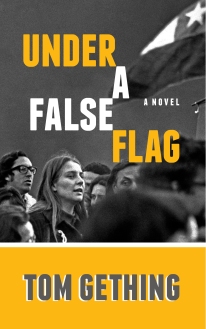
Traditional Day of the Dead graveside offerings in Oaxaca: cigarettes, tortillas, mole, decorated bread, fruit, beer and, of course, mescal.
Photo credit: T. Gething
Yesterday marked the end of los Días de los Muertos—the Days of the Dead—that syncretic Mexican celebration of Mesoamerican and Catholic beliefs encompassing Halloween, All Saints’ Day and All Souls’ Day. During this time Mexican families traditionally clean up and adorn the graves of their relatives, then spend a night of vigil, eating and drinking, singing and playing music, praying for and remembering the deceased.
Two great novels capture the mood of this annual event. One is Malcolm Lowry’s Under the Volcano, which takes place on November 2, 1938. It’s a masterpiece for many reasons, not least for its atmospheric descriptions of this largely indigenous celebration.
 The other book isn’t directly linked to the Day of the Dead but might as well be. It’s Juan Rulfo’s enigmatic masterpiece, Pedro Páramo. I spent part of yesterday rereading this little gem, a novella of less than 50,000 words that is perhaps the greatest and most influential Mexican fiction yet written.
The other book isn’t directly linked to the Day of the Dead but might as well be. It’s Juan Rulfo’s enigmatic masterpiece, Pedro Páramo. I spent part of yesterday rereading this little gem, a novella of less than 50,000 words that is perhaps the greatest and most influential Mexican fiction yet written.
This is the fourth time I’ve read it—twice in a translation by Lysander Kemp, once in the original Spanish, and now in a newer and more faithful translation by Margaret Sayers Peden. The first time I read it during the graveyard shift while working as a security guard at the university library in Tucson forty years ago. I remember being transfixed by the spare, poetic magic of Rulfo’s prose. I am still spellbound by it.
Rulfo published only two slim books in his lifetime, a collection of stories, El llano en llamas (The Burning Plain and Other Stories) and Pedro Páramo. The former was published in 1953 and the latter in 1955. Rulfo spent much of his career as a traveling tire salesman and pursued another artistic passion, photography, as he made sales trips around the country. Although there were rumors he was working on another novel, La Cordillera, he revealed shortly before his death in 1986 that he had destroyed his work in progress.
According to Susan Sontag who wrote the introduction to the most recent English edition, Rulfo once said: “In my life there are many silences. In my writing, too.”
That statement summarizes the mystery of his writing, but it hardly explains how he accomplished it. Rulfo’s prose is inimitable and perfect, whether he was writing about illiterate adulterers who have murdered her husband and are obsessed by their sin, as in the haunting story “Talpa,” or about desperate revolutionaries ambushed in a canyon, as in “The Burning Plain.” Rulfo’s economy with dialogue and narrative exposition, his use of non-chronological sequences and time shifts add a strange intensity to his writing; his prose burns with unspoken emotion. (Not surprisingly, his black-and-white photographs express the same silences and economies, as if they were renderings of his books in images.)

Juan Rulfo’s photography mirrors the spare, stark form of his fiction. Published by Smithsonian Books (2002).
Here’s an example of Rulfo’s prose from the early pages of Pedro Páramo, but really any section of the book matches it in tone:
It was during the dog days, the season when the August wind blows hot, venomous with the rotten stench of saponaria blossoms.
The road rose and fell. It rises or falls depending on whether you’re coming or going. If you are leaving, it’s uphill; but as you arrive it’s downhill.
“What did you say that town down there is called?”
“Comala, señor.”
“You’re sure that’s Comala?”
“I’m sure, señor.”
“It’s a sorry-looking place, what happened to it?”
“It’s the times, señor.”
Pedro Páramo is considered a precursor of magical realism; Gabriel García Márquez admired it so much he memorized entire passages. But the novel has more kinship with surrealism than magical realism.
Simply stated, it is the story of Juan Preciado, a young man who goes to Comala, the village of his dead mother, in search of his father, Pedro Páramo. At least that’s how it begins, but soon you realize nothing is quite normal. Pedro Páramo, Preciado learns, is long dead. The town is deserted and voices of the dead fill his ears. The story jumps in time and point of view, from the first person to the third, numerous times. Soon you wonder if everyone isn’t dead, including Preciado, and if these aren’t voices from a horrible past unburdening themselves of their losses and the grief caused by their cruel patrón. Pedro Páramo owned all the land around, controlling and abusing the people subsisting underneath him, taking what he wanted—land, men’s lives, other men’s wives—as he pleased.
Rulfo tapped a deep vein of Mexican experience in his indictment of the greedy landowners who used the turmoil of the revolution to their advantage, behaving like feudal lords in their own isolated worlds. The poor, the illiterate, the weak suffered at their hands, living in terror, haunted by violent death—it is a fatalistic, distinctly Mexican vision that resonates across time and place. For what is the difference between Pedro Páramo and the Mexican drug lords of today who use corruption and intimidation to control their turf? And, as the unearthed mass graves reveal, what awaits those who must live with such terror but death and decay?
Rulfo wrote about another time, about a poor, superstitious and oppressed Mexico devastated by lawlessness from years of revolution and brigandage, but it could be now, and it could be many places.






